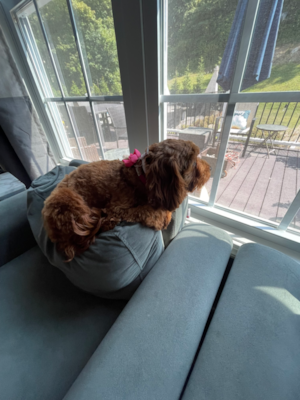
Cavapoos are famous for their affectionate nature and strong desire for companionship. These dogs epitomize the ideal of a companion dog, always seeking closeness with their humans. Despite their need for constant interaction, Cavapoos possess varying degrees of independence. This begs the question: can Cavapoos be left alone?
The answer isn't as straightforward as we’d like due to the individual personalities found within the breed. While some Cavapoos exhibit independence and can manage alone time for up to 8 hours, others form intense attachments to their owners, showing signs of distress if separated for just a few hours.
Table of Contents
How Long Can Cavapoos Be Left Alone?
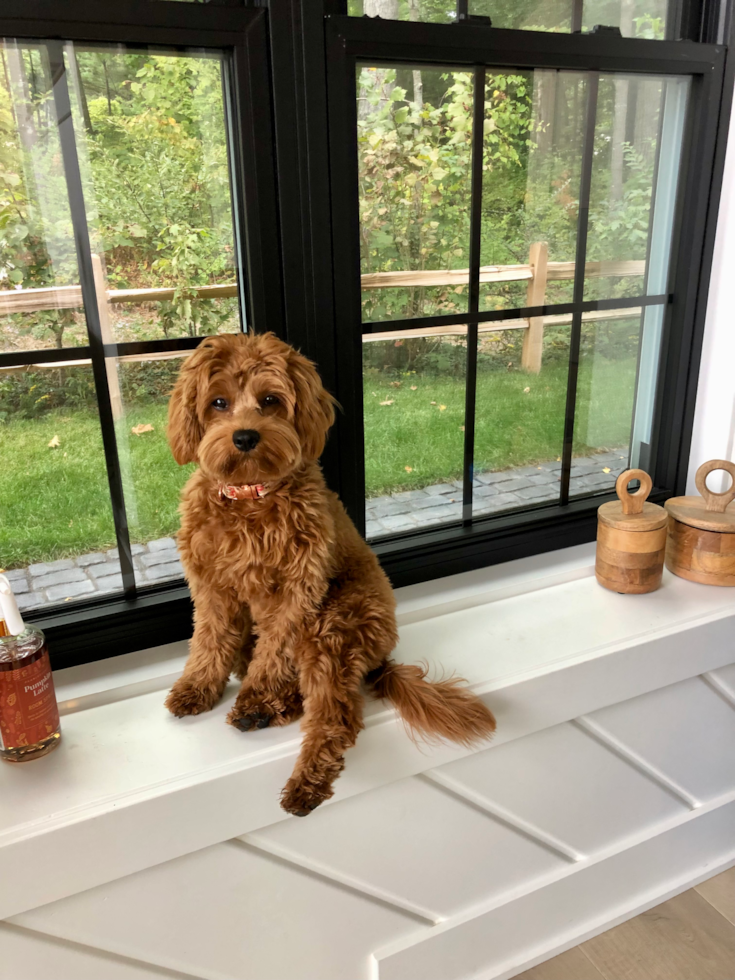
Premier Pups Customer Photo of a beautiful brown Cavapoo sitting by the window
Determining the exact duration Cavapoos can be left alone without experiencing separation anxiety is not an exact science. It heavily depends on the dog's personality, age, and how accustomed they are to being alone. Generally speaking, Cavapoos, like many other companion dog breeds, can manage alone time for 2 to 3 hours without showing signs of distress. However, this period can vary significantly.
Understanding Your Cavapoo's Personality
Cavapoos inherit traits from both the Cavalier King Charles Spaniel and the Poodle, making them adaptable, intelligent, and affectionate. Their ability to be left alone will depend on which traits they express more strongly. A Cavapoo with more Poodle-like independence might manage longer periods of solitude better than one with the clingier characteristics of the Cavalier King Charles Spaniel.
RELATED: Everything You Need To Know About The Cavapoo’s Temperament
Age Matters
Puppies and senior dogs have different needs. Cavapoo puppies, being in a crucial stage of development, require more frequent attention, including for bathroom breaks, feeding, and socialization. Therefore, they shouldn't be left alone for more than 2 hours. On the other hand, adult Cavapoos, especially those that have been properly trained and conditioned, can sometimes be left alone for up to 5-6 hours. Senior Cavapoos, much like puppies, may need more frequent care due to health issues or decreased bladder control and should not be left alone for extended periods.
RELATED: Do Cavapoos Have Health Problems?
Training and Conditioning Your Cavapoo
Training plays a crucial role in how well a Cavapoo can handle being alone. Start with short periods of separation and gradually increase the duration as your dog becomes more comfortable. Use positive reinforcement to create a positive association with alone time. Training aids such as treat-dispensing toys can be helpful.
RELATED: The Ultimate Guide to Training Your Cavapoo
Creating a Safe and Comfortable Environment For Your Cavoodle
Ensuring that your Cavapoo has a safe, comfortable environment is crucial for their well-being when left alone. This includes access to fresh water, a comfortable sleeping area, and a variety of toys to keep them entertained. Consider safety-proofing areas where your Cavapoo will spend time alone to prevent accidents.
Signs of Separation Anxiety in Cavapoos
Be on the lookout for signs of separation anxiety, which can include destructive behavior, excessive barking or whining, and accidents in the house. If you notice any of these signs, it may be necessary to adjust the duration you leave your Cavapoo alone and consult a professional for advice on managing separation anxiety.
RELATED: How to Treat Your Dog’s Separation Anxiety
Should A Cavapoo Be Left Alone in a Crate?
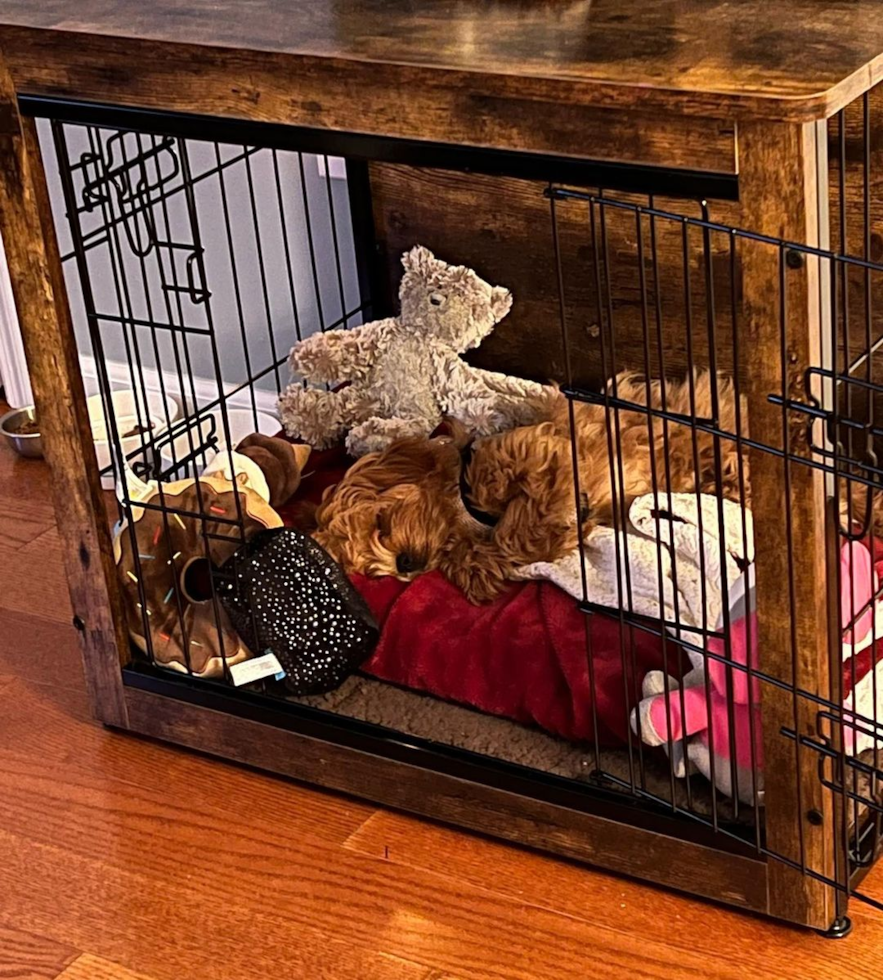
Premier Pups Customer Photo of a lovely Cavapoo sleeping in a crate
Crating is a practice that can evoke mixed feelings among pet owners. However, when approached correctly, it can offer numerous benefits for both Cavapoos and their owners. Understanding how to use a crate responsibly can ensure it serves as a secure and calming space for your dog, rather than a source of stress.
The Benefits of Crating a Cavapoo
Crating, when used appropriately, can aid in several aspects of pet care, including:
Safety: A crate keeps your Cavapoo safe from household hazards when unsupervised.
Anxiety Reduction: For some dogs, a crate can act as a den-like space where they feel secure and relaxed.
House Training: Crates can be instrumental in establishing a house-training routine, as dogs naturally avoid soiling their sleeping area.
Travel: A crate can make traveling with your Cavapoo safer and less stressful for both of you.
Choosing the Right Crate for a Cavapoo
Selecting the appropriate crate size and type is crucial. Your Cavapoo should have enough room to stand up, turn around, and lie down comfortably. Crates come in various materials, including wire, plastic, and soft-sided. Each has its pros and cons, depending on your and your Cavapoo's needs. Wire crates offer good ventilation and visibility, plastic crates are cozy and approved for airline travel, and soft-sided crates are lightweight and portable.
Positive Crate Training
The key to successful crating is ensuring your Cavapoo associates their crate with positive experiences. Here are some tips for positive crate training:
Gradual Introduction: Start by allowing your Cavapoo to explore the crate with the door open, using treats and toys to encourage them inside.
Comfortable Setup: Make the crate inviting with a soft bed or blanket and perhaps a chew toy to keep them occupied.
Mealtimes: Feed your Cavapoo in their crate to create a positive association.
Short Durations: Initially, leave your Cavapoo in their crate for short periods while you are home, gradually increasing the time as they become more comfortable.
RELATED: How To Crate Train A Puppy
Monitoring Your Cavapoo's Response
Pay attention to how your Cavapoo responds to being crated. Signs of distress, such as excessive whining, barking, or attempts to escape, indicate that the crate may not be the best option for your dog, or that adjustments are needed in your training approach.
Alternatives to Crating
If crating does not suit your Cavapoo, consider alternatives like pet-proofing a room or area of your home where they can stay safely unsupervised. Baby gates are useful tools for restricting access to certain areas while still giving your pet the freedom to move around.
How Much Time Can You Leave a Cavapoo Alone?
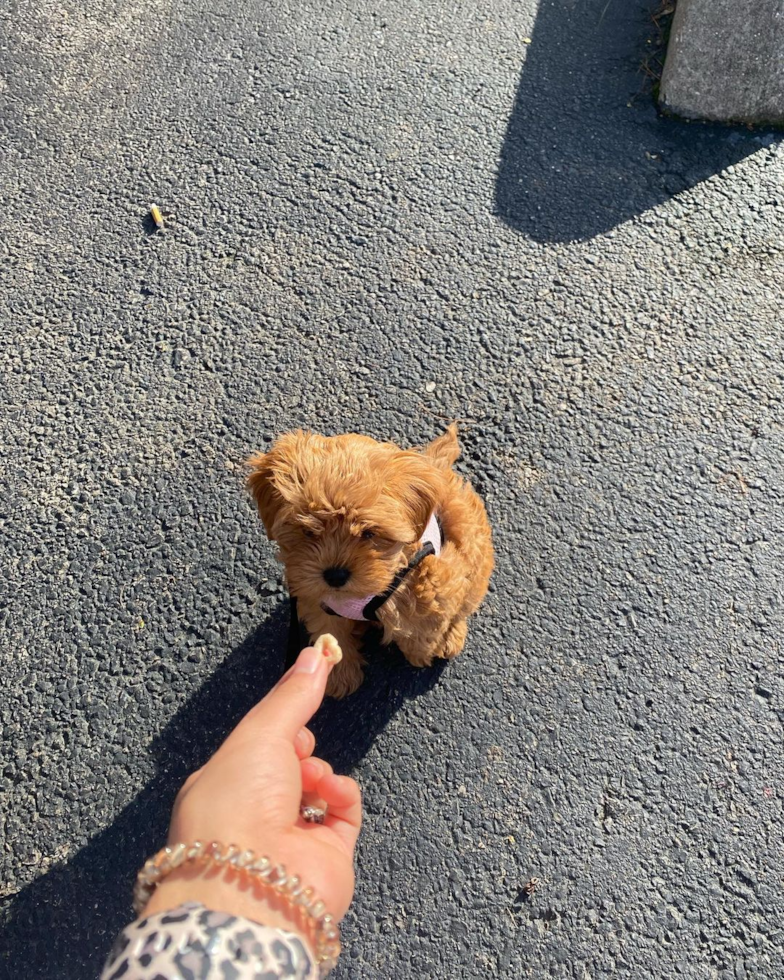
Premier Pups Customer Photo of a tiny Cavapoo being trained
Determining the ideal amount of time you can leave your Cavapoo alone requires balancing their emotional well-being with the practicalities of daily life. While we've established that Cavapoos can manage alone for short periods, the exact duration depends on several factors, including their training, age, and health.
Training and Conditioning for Alone Time
The foundation for leaving your Cavapoo alone comfortably lies in proper training and conditioning. This process involves:
Gradual Introduction: Start leaving your Cavapoo alone for short periods and gradually increase the duration as they show comfort and confidence.
Routine Establishment: Consistent routines help Cavapoos understand when to expect periods of solitude, reducing anxiety.
Mental Stimulation: Providing toys that stimulate your Cavapoo's mind can keep them occupied and reduce the stress of being alone.
Age Considerations in Cavapoos
Puppies
Cavapoo puppies should not be left alone for more than 2 hours at a time. Their developmental stage requires frequent socialization and potty breaks.
Adults
Adult Cavapoos, with proper training, can be left alone for 4 to 6 hours. This duration can vary based on their individual training and temperament.
Seniors
Older Cavapoos may require more frequent attention due to health concerns or decreased bladder control, making it advisable not to leave them alone for extended periods.
Health and Well-being
A Cavapoo's health status plays a crucial role in determining how long they can be left alone. Dogs with medical conditions or those requiring medication may need more frequent care. Always consider your pet's health needs when planning their alone time.
Creating a Comfortable Environment
Ensuring your Cavapoo is comfortable while alone can significantly impact their ability to handle solitude. This includes:
Access to Water: Make sure your Cavapoo has fresh water available.
Safe Space: Provide a comfortable, safe area where your Cavapoo feels secure, whether it's a crate or a pet-proofed room.
Physical Exercise: Adequate exercise before a period of alone time can help your Cavapoo relax and rest while you're away.
Signs Your Cavapoo is Independent vs. Attached
Understanding your Cavapoo's personality—whether they lean more towards independence or attachment—can significantly affect how you approach leaving them alone. Recognizing the signs early on can help you tailor their care and training to suit their needs better, ensuring they're happy and healthy.
Independent Cavapoos
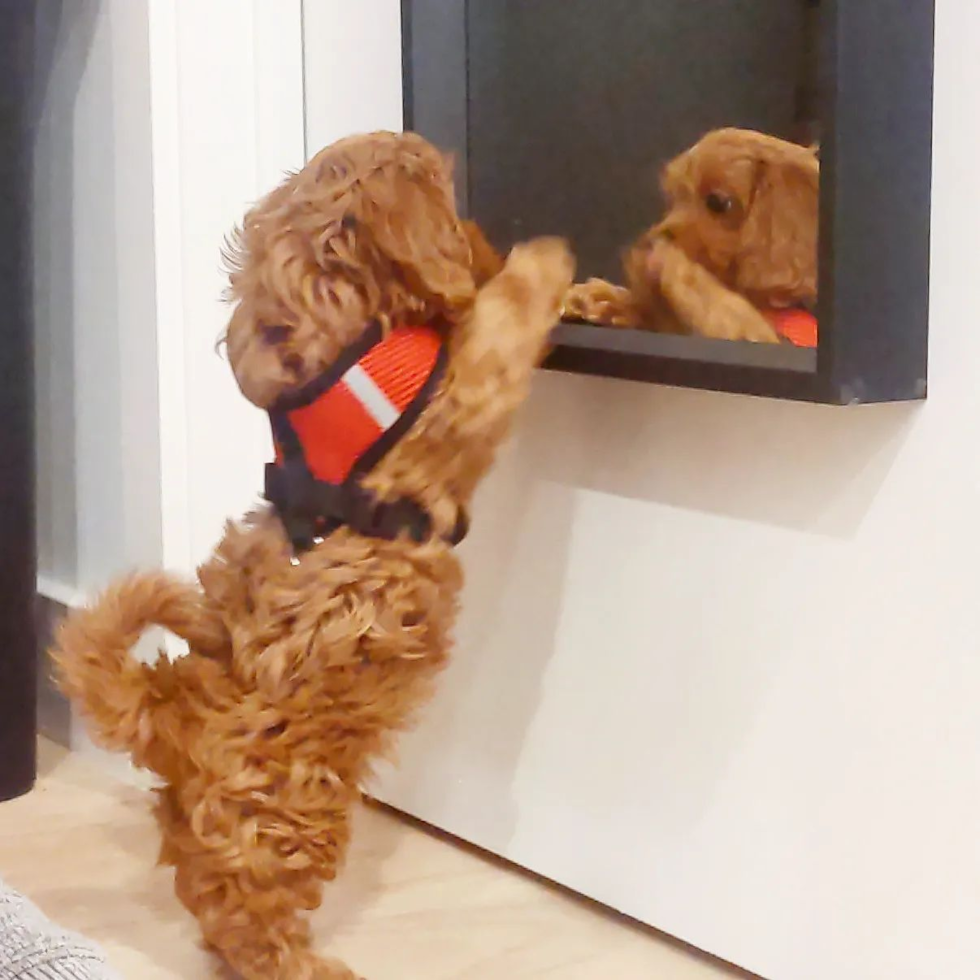
Premier Pups Customer Photo of a playful Cavapoo looking in the mirror
Independent Cavapoos are usually self-sufficient and find ways to entertain themselves when you're not around. Here are some indicators that your Cavapoo has an independent streak:
- Self-Entertainment: They play with their toys alone, often engaging in solo activities without seeking constant interaction.
- Calm Demeanor: Exhibits a calm demeanor when you prepare to leave, showing no signs of distress.
- Comfortable Solitude: They can comfortably spend time in their crate or designated area without showing anxiety or destructive behavior.
Attached Cavapoos
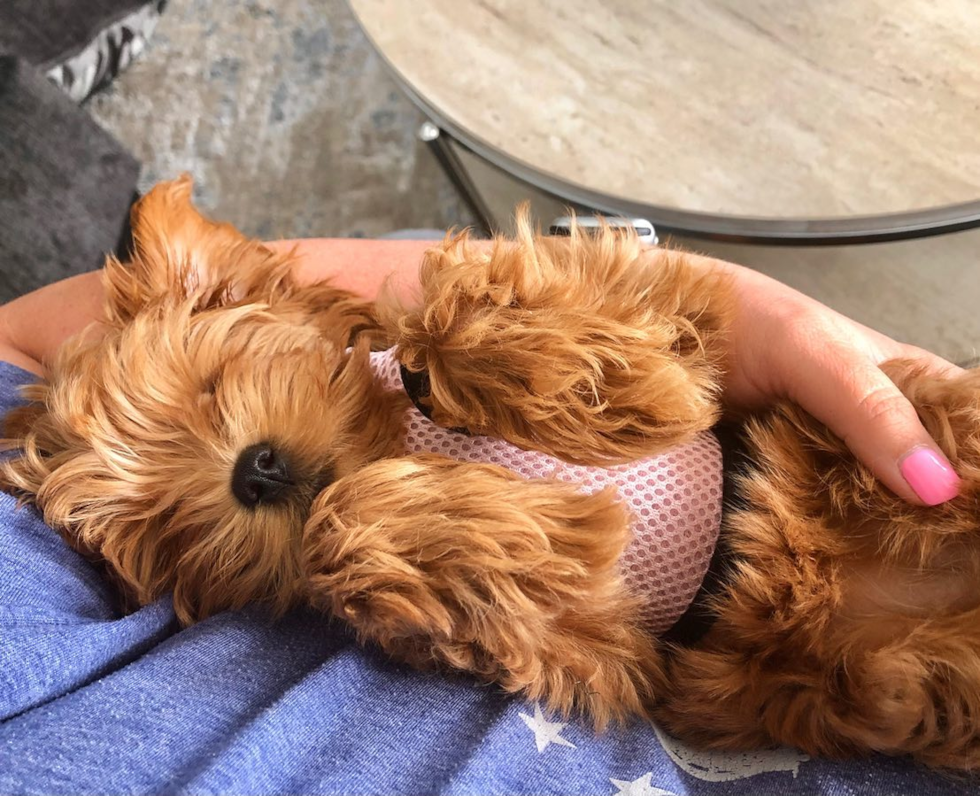
Premier Pups Customer Photo of a sweet Cavapoo sleeping in its owner's arms
Attached Cavapoos exhibit a strong desire for constant companionship and may struggle more with being left alone. Signs of an attached Cavapoo include:
- Following Behavior: They follow you from room to room, always wanting to be by your side.
- Distress Signals: Shows signs of distress (whining, barking, pacing) when they sense you are leaving.
- Separation Anxiety: Demonstrates separation anxiety symptoms, such as destructive behavior or accidents in the house when alone.
- Difficulty with Solitude: Struggles to stay calm and occupied in their crate or designated area without you nearby.
Nurturing an Independent Cavapoo
If your Cavapoo shows signs of independence, nurturing this trait can help them become more self-reliant and content when alone. Encourage play with interactive toys and create a safe, engaging environment where they feel comfortable exploring on their own.
Supporting an Attached Cavapoo
For attached Cavapoos, gradual training to increase their comfort with being alone is key. This includes short, positive separations and slowly extending the time you're away. Providing a warm, comfortable space with familiar scents and objects can also help ease their anxiety.
The Importance of Early Identification
Identifying whether your Cavapoo is independent or attached early on allows for a more tailored approach to their care, training, and how you manage their alone time.
Tips for Teaching Your Cavapoo to Handle Alone Time Well
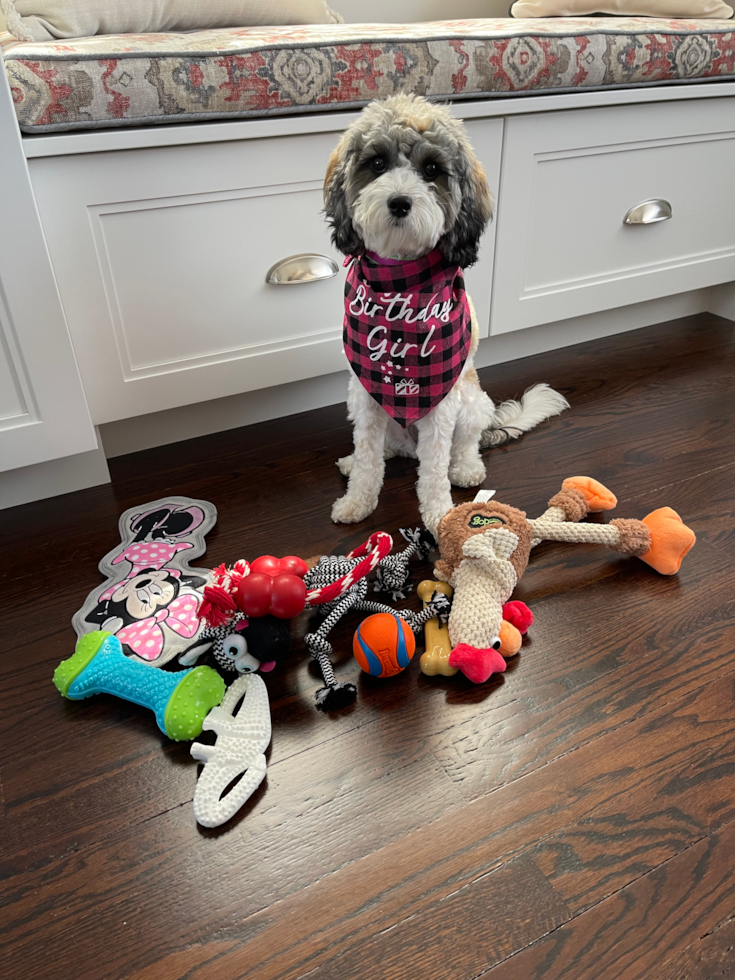
Premier Pups Customer Photo of a happy Cavapoo surrounded by dog toys
Helping your Cavapoo become comfortable with alone time is essential for their well-being and your peace of mind. Here are practical steps to teach your Cavapoo to embrace solitude positively:
Gradual Introduction to Alone Time
Start by leaving your Cavapoo alone for just a few minutes at a time and gradually increase the duration. This slow introduction helps prevent anxiety buildup, making alone time a normal part of their routine.
Create Positive Associations with Alone Time
Use treats, favorite toys, and comfortable bedding to make alone time enjoyable for your Cavapoo. Consider a special toy that they only get when they’re alone to make this time something they look forward to.
Ensure Plenty of Exercise Before Leaving
A well-exercised Cavapoo is more likely to rest and relax during your absence. Engage in physical activities or long walks to expend their energy before you leave.
Use Background Noise
Leaving a radio or TV on can mimic the presence of people, providing comfort and reducing the feeling of loneliness. The sounds can help soothe your Cavapoo and make them feel less isolated.
Establish a Goodbye Routine
Creating a consistent goodbye routine can help your Cavapoo understand that you will return. This might include a specific phrase you say, a pat on the head, or a goodbye treat.
Use of Interactive Toys
Interactive toys can keep your Cavapoo engaged and mentally stimulated while alone. Toys that dispense treats or require problem-solving can be particularly effective.
Monitor and Adjust
Pay close attention to how your Cavapoo reacts to being alone and adjust your strategies as needed. If signs of anxiety or distress are observed, it may be necessary to shorten the alone time or consult a professional.
Tips for Leaving Your Cavapoo Alone for the First Time
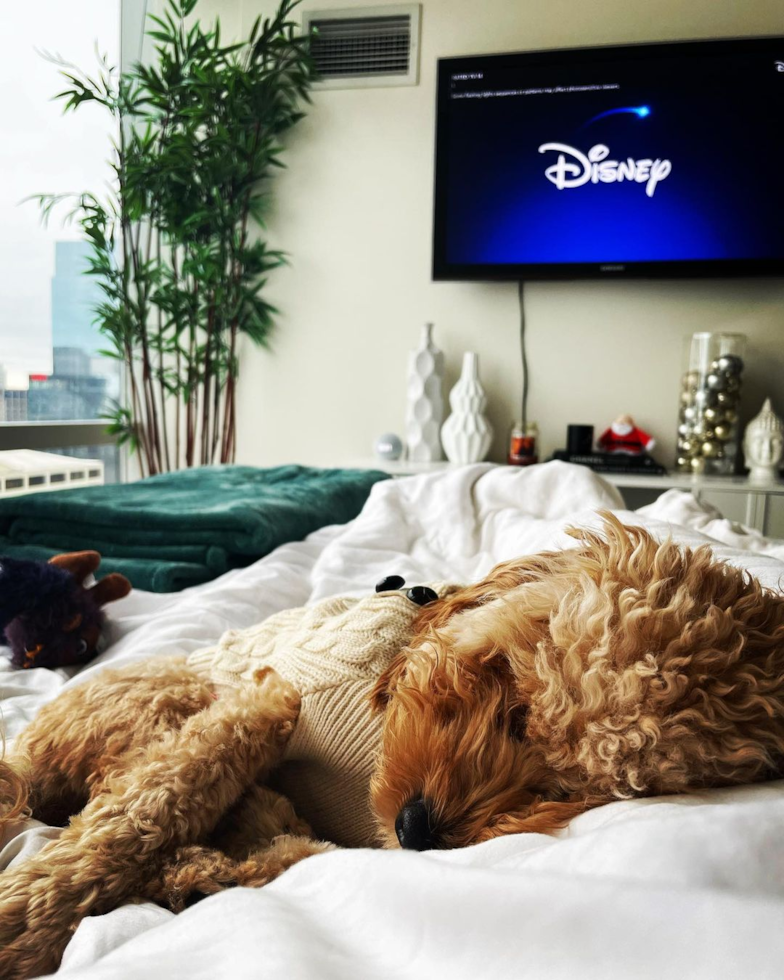
Premier Pups Customer Photo of a Cavapoo sleeping with the TV on
Leaving your Cavapoo alone for the first time can be a significant milestone for both you and your pet. Here’s how to make this transition as smooth as possible:
Start With Short Intervals
Begin by leaving your Cavapoo alone for just a few minutes and gradually extend the time. This helps build their confidence and reduces potential anxiety associated with your absence.
Create a Comfortable Space
Ensure your Cavapoo has a cozy and secure area where they feel safe. This could be a crate if they are crate-trained, or a pet-proofed room with their bed, toys, and water.
Leave Calmly
Minimize the drama of departures. A calm goodbye can help prevent anxiety in your Cavapoo, signaling that being alone is a normal and not stressful event.
Monitor Their Behavior
Consider using a pet camera to watch how your Cavapoo copes in your absence. This can give you insights into their stress levels and help you adjust the duration of alone time accordingly.
Provide Entertainment
Leave interactive toys or puzzles to keep your Cavapoo occupied. This can help divert their attention from your absence and reduce boredom or stress.
Practice Routine
Maintain a routine around your departures and returns to build predictability. Having a routine can reassure your Cavapoo and help them understand that you will always come back.
Ensure Basic Needs Are Met
Before leaving, make sure your Cavapoo has everything they need—fresh water, a comfortable place to rest, and access to the bathroom area if they’re going to be alone for more than a couple of hours.
Positive Reinforcement
Upon returning, reward your Cavapoo with attention and treats to reinforce that being alone is a temporary and positive situation.
Gradual Increase in Alone Time
As your Cavapoo gets more comfortable with being alone, you can gradually increase the duration. Watch for signs of stress or anxiety and adjust as necessary.
Seek Professional Advice if Needed
If your Cavapoo struggles significantly with being alone, consider seeking advice from a professional dog trainer or behaviorist who can offer tailored strategies.
Conclusion
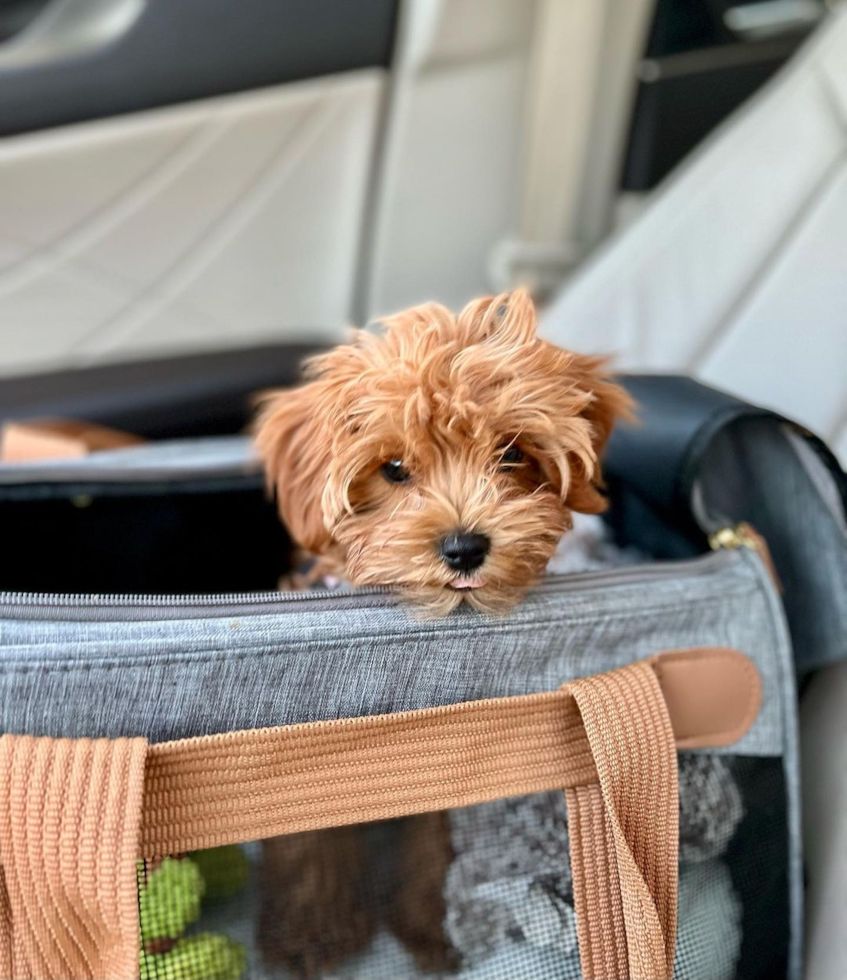
Premier Pups Customer Photo of an adorable Cavapoo in a dog travel bag
While Cavapoos are inherently social creatures that thrive on companionship, they can learn to be alone for reasonable periods. The key to achieving this lies in understanding your dog's personality, providing proper training, and ensuring their comfort and safety when alone.
What To Read Next
Cavapoo Lifespan: Secrets to Longevity
Are Cavapoos Energetic?
Frequently Asked Questions
Can I leave my Cavapoo alone for 8 hours? Leaving a Cavapoo alone for 8 hours is not recommended, especially for puppies, seniors, or dogs that haven’t been conditioned for long periods of solitude. Adult Cavapoos that are well-adjusted and have been gradually accustomed to longer periods alone may manage, but it’s crucial to ensure they have everything they need and that their space is safe and comfortable. Frequent breaks, access to fresh water, and engaging toys are essential.
Do Cavapoos get separation anxiety? Yes, Cavapoos can get separation anxiety, similar to other dog breeds. This condition is characterized by distress and behavior problems when left alone. Symptoms can include excessive barking or whining, destructive behavior, and accidents. Early training to get accustomed to alone time, along with strategies to reduce anxiety, can help mitigate this.
How long can you leave a Cavoodle alone? A Cavoodle, another name for Cavapoo, should ideally not be left alone for more than 4-5 hours at a time. Puppies and senior dogs require more frequent attention and should be left alone for shorter periods. Creating a positive and safe environment and gradually getting them used to alone time can help extend this duration responsibly.
Do Cavoodles cry? Cavoodles may cry or whine, especially if they experience anxiety or discomfort, including when left alone. Addressing the root cause of the crying, such as separation anxiety, boredom, or the need for more physical activity and interaction, is crucial. Ensuring they have a comfortable, engaging environment when alone can help reduce crying.
Where should Cavoodles sleep? Cavoodles should sleep in a safe, comfortable spot that they recognize as their own. Many owners find that a dog bed in their bedroom or a crate (if crate training is used positively) works well. The key is to ensure the sleeping area is cozy, quiet, and in a temperature-controlled environment, fostering a sense of security and routine.
How do Cavapoos react to being left alone? The reaction of Cavapoos to being left alone varies widely among individual dogs. Some may show signs of independence and cope well, entertaining themselves and resting. Others may experience anxiety or distress, demonstrated by behaviors like excessive barking, destruction, or accidents.




